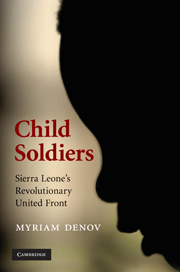Book contents
- Frontmatter
- Contents
- Acknowledgements
- Map
- Introduction: Child soldiers, iconography and the (il)logic of extremes
- 1 Children's involvement in war: The quandary of structure and agency
- 2 Recipe for rebellion: Civil war in Sierra Leone
- 3 Negotiating power: Research on and by child soldiers
- 4 ‘Becoming RUF’: The making of a child soldier
- 5 ‘Being RUF’: Victimization, participation and resistance
- 6 ‘Put dey gon don’: The unmaking of a child soldier
- 7 New battlefields
- References
- Index
6 - ‘Put dey gon don’: The unmaking of a child soldier
Published online by Cambridge University Press: 04 May 2010
- Frontmatter
- Contents
- Acknowledgements
- Map
- Introduction: Child soldiers, iconography and the (il)logic of extremes
- 1 Children's involvement in war: The quandary of structure and agency
- 2 Recipe for rebellion: Civil war in Sierra Leone
- 3 Negotiating power: Research on and by child soldiers
- 4 ‘Becoming RUF’: The making of a child soldier
- 5 ‘Being RUF’: Victimization, participation and resistance
- 6 ‘Put dey gon don’: The unmaking of a child soldier
- 7 New battlefields
- References
- Index
Summary
You were only recognized as somebody if you were carrying a gun.
You felt like you belonged.
You felt powerful and protected …
Without your gun you were shit.
(Boy)At the conflict's end, with the disbandment of the RUF imminent and with the guns gradually falling silent, returning to a civilian existence became an ever-increasing reality for the child soldiers in this study. However, given the profound meaning that holding a gun roused, disarmament and returning from the bush was an invariably complex and sometimes conflicting experience. As indicated by the participant in the above quotation, for some children, putting down the gun often meant relinquishing power and protection, renouncing a part of their identity and losing a sense of belonging. For others, it meant a newly found freedom and relief from a militarized world that they had longed to escape. For most children, it meant each of these realities (and others) simultaneously. As discussed in the book's introduction, there has been a tendency to assume that in the post-conflict period, former child soldiers are destined to a life of pathology, disorder and deviance. Although the process of disarmament, demobilization and reintegration may be highly challenging, for both the child soldiers themselves and the communities that are expected to reabsorb them, such assumptions are overstated and premature.
- Type
- Chapter
- Information
- Child SoldiersSierra Leone's Revolutionary United Front, pp. 145 - 179Publisher: Cambridge University PressPrint publication year: 2010

